Comparative Analysis of Dust and Noise Emission in Aggregate Production Systems
Abstract
:1. Introduction
2. Research Significance and Novelty
3. Materials and Methods
4. Results
4.1. Noise Level Measurements
4.2. Dust Pollution Results
5. Discussion
6. Summary
7. Patents
- Author: Gawenda T.: Układ urządzeń do produkcji kruszyw foremnych, AGH w Krakowie. Patent No. PL233689B1 granted on 7 August 2019.
- Author: Gawenda T.: Wibracyjny przesiewacz wielopokładowy, AGH w Krakowie. Patent No. PL 231748 B1 granted on 12 June 2018.
Author Contributions
Funding
Acknowledgments

Conflicts of Interest
References
- Rajan, B.; Singh, D. Understanding influence of crushers on shape characteristics of fine aggregates based on digital image and conventional techniques. Constr. Build. Mater. 2017, 150, 833–843. [Google Scholar] [CrossRef]
- Jamkar, S.S.; Rao, C.B.K. Index of Aggregate Particle Shape and Texture of coarse aggregate as a parameter for concrete mix proportioning. Cem. Concr. Res. 2004, 34, 2021–2027. [Google Scholar] [CrossRef]
- Naziemiec, Z. Processing and Testing of Mineral Aggregates; AGH Publishing House: Cracow, Poland, 2019. (In Polish) [Google Scholar]
- Lilic, N.; Cvjetic, A.; Knezevic, D.; Milisavljevic, V.; Pantelic, U. Dust and Noise Environmental Impact Assessment and Control in Serbian Mining Practice. Minerals 2018, 8, 34. [Google Scholar] [CrossRef] [Green Version]
- Saramak, A.; Naziemiec, Z.; Saramak, D. Analysis of noise emission for selected crushing devices. Min. Sci. 2016, 23, 145–154. [Google Scholar] [CrossRef]
- Gawenda, T. The influence of rock raw materials comminution in various crushers and crushing stages on the quality of mineral aggregates. Gospod. Surowcami Miner.-Miner. Resour. Manag. 2013, 29, 53–65. [Google Scholar] [CrossRef]
- Tomach, P. Study of intensification of the milling process in the vibratory mill. Przemysł Chem. 2017, 96, 1893–1897. [Google Scholar]
- Feliks, J.; Tomach, P.; Foszcz, D.; Gawenda, T.; Olejnik, T. Research on the New Drive of a Laboratory Screen with Rectilinear Vibrations in Transient States. Energies 2021, 14, 8444. [Google Scholar] [CrossRef]
- Jeswiet, J.; Szekeres, A. Energy Consumption in Mining Comminution. Procedia CIRP 2016, 48, 140–145. [Google Scholar] [CrossRef] [Green Version]
- Lindqvist, M. Energy considerations in compressive and impact crushing of rock. Miner. Eng. 2008, 21, 631–641. [Google Scholar] [CrossRef]
- Baruti, B.; Peci, N.; Vitaku, A.; Malollari, I.; Zeqiri, R.; Kelmendi, M. Analysis of the possibilities of decreasing the impact of crushing operations on environment. J. Environ. Prot. Ecol. 2011, 12, 2056–2061. [Google Scholar]
- Zawada, J. Introduction to Mechanics of Crushing Operations; Publishing House and Printing Institute of Department of Operation Technology: Radom, Poland, 1998. [Google Scholar]
- Naziemiec, Z.; Gawenda, T. Assessment of Comminution Effects in Various Crushers. In Scientific Papers of the Institute of Mining; Wrocław University of Technology: Wrocław, Poland, 2006. [Google Scholar]
- Chief Environmental Protection Inspectorate. Analysis of Air Pollution with PM10 and PM 2.5 Particles, with Consideration of Chemical Composition of Dust and Influence of Natural Pollutions; Report of Inspection of Environmental Protection; Chief Environmental Protection Inspectorate: Warsaw, Poland, 2009.
- Environment Condition in Poland—Signals 2011. In Central Inspectorate of Environmental Protection; Library of Environmental Monitoring: Warsaw, Poland, 2011.
- Ohrstrom, E. Longitudinal survey on effects of changes in road traffic noise annoyance, activity disturbances, and psychosocial well being. J. Acoust. Soc. Am. 2006, 115, 719–729. [Google Scholar] [CrossRef]
- Sairanen, M.; Rinne, M. Dust emission from crushing of hard rock aggregates. Atmos. Pollut. Res. 2019, 10, 656–664. [Google Scholar] [CrossRef]
- Sidor, J.; Feliks, J.; Mazur, M.; Tomach, P. Vibration technique in mineral processing. In Proceedings of the Mechanizacja, Automatyzacja i Robotyzacja w Górnictwie 2015, International Conference, Cracow, Poland, 23–27 February 2015; pp. 102–111. [Google Scholar]
- Wodziński, P. Fine screening and screens. Inżynieria Miner. J. Pol. Miner. Eng. Soc. 2001, 1, 41–57. [Google Scholar]
- Siewior, J.; Tumidajski, T.; Foszcz, D.; Niedoba, T. Prediction of air pollutants concentrations in GOP using statistical models. Annu. Set Environ. Prot. 2011, 13, 1261–1274. [Google Scholar]
- Tumidajski, T.; Foszcz, D.; Niedoba, T.; Siewior, J. Stochastic models of air pollution in industrial agglomerations. In Proceedings of the Air Protection 2008, International Conference, Kosice, Slovakia, 26–28 November 2008; pp. 128–132. [Google Scholar]
- National Pollutant Inventory. Emission Estimation Technique Manual for Mining; Report 2012; Department of Sustainability, Environment, Water Population and Communities: Melbourne, Australia, 2012.
- Lal, B.; Tripathy, S.S. Prediction of dust concentration in open cast coal mine using artificial neural network. Atmos. Pollut. Res. 2012, 3, 211–218. [Google Scholar] [CrossRef] [Green Version]
- Roy, S.; Adhikari, G.; Renaldy, T.; Jha, A. Development of Multiple Regression and Neural Network Models for Assessment of Blasting Dust at a Large Surface Coal Mine. J. Environ. Sci. Technol. 2011, 4, 284–301. [Google Scholar] [CrossRef]
- Chelani, A.B.; Gajghate, D.; Hasan, M. Prediction of Ambient PM10 and Toxic Metals Using Artificial Neural Networks. J. Air Waste Manag. Assoc. 2002, 52, 805–810. [Google Scholar] [CrossRef]
- McKendry, I.G. Evaluation of Artificial Neural Networks for Fine Particulate Pollution (PM10 and PM2.5) Forecasting. J. Air Waste Manag. Assoc. 2002, 52, 1096–1101. [Google Scholar] [CrossRef] [Green Version]
- Nagendra, S.M.S.; Khare, M. Modelling urban air quality using artificial neural network. Clean Technol. Environ. Policy 2005, 7, 116–126. [Google Scholar] [CrossRef]
- Suhanek, M.; Grubesa, S. Innovative Approaches to Noise Reduction. In Noise and Environment; Siano, D., González, A.E., Eds.; IntechOpen: London, UK, 2020. [Google Scholar] [CrossRef]
- Fang, C.-F.; Ling, D.-L. Guidance for noise reduction provided by tree belts. Landsc. Urban Plan. 2005, 71, 29–34. [Google Scholar] [CrossRef]
- Martínez-Sala, R.; Rubio, C.; Garcia-Raffi, L.M.; Sánchez-Pérez, J.V.; Pérez, E.A.S.; Llinares, J. Control of noise by trees arranged like sonic crystals. J. Sound Vib. 2006, 291, 100–106. [Google Scholar] [CrossRef]
- Assessment and Management of Noise Level in Environment. Council of Europe and European Parliament Directive 2002/49/WE; Commission in the Conciliation Committee: Brussels, Belgium, 2002. [Google Scholar]
- Environmental Protection Law. Act of 27 of April 2001. J. Laws 2001, 62, item 627. [Google Scholar]
- Regulation of the Minister of the Environment w sprawie wymagań w zakresie prowadzenia pomiarów wielkości emisji oraz pomiarów ilości pobranej wody. J. Laws 2008, 206, item 1291.
- Susanto, A.; Setyawan, D.O.; Setiabudi, F.; Savira, Y.M.; Listiarini, A.; Putro, E.K.; Muhamad, A.F.; Wilmot, J.C.; Zulfakar, D.; Kara, P.; et al. GIS-based mapping of noise from mechanized minerals ore processing industry. Noise Mapp. 2021, 8, 1–15. [Google Scholar] [CrossRef]
- Air Quality in Europe-2018; Report 12/2018; EEA European Environmental Agency: København, Denmark, 2018.
- Air Pollution Fact Sheet 2014—Poland; EEA European Environmental Agency: København, Denmark, 2014.
- Saramak, A. Comparative analysis of indoor and outdoor concentration of PM10 particulate matter on example of Cracow City Center. Int. J. Environ. Sci. Technol. 2019, 16, 6609–6616. [Google Scholar] [CrossRef] [Green Version]
- Saramak, A.; Naziemiec, Z. Determination of Dust Emission Level for Various Crushing Devices. Min. Sci. 2019, 26, 45–54. [Google Scholar] [CrossRef]
- Technical Guide for Industrial Emissions Reduction; Report 26; AIRUSE: Mississauga, ON, Canada, 2016.
- Gawenda, T. Układ Urządzeń do Produkcji Kruszyw Foremnych. Patent PL 233689 B1; AGH UST: Mississauga, ON, Canada, 2019. [Google Scholar]
- Fan, Y.; Zhiyi, B.; Zhujun, Z.; Jiani, L. The investigation of noise attenuation by plants and the corresponding noise-reducing spectrum. J. Environ. Health 2010, 72, 8–15. [Google Scholar] [PubMed]
- Stopczyk, M. (Ed.) Elektrodiagnostyka Medyczna; PZWL: Warsaw, Poland, 1984. [Google Scholar]
- International Standard IEC 61672-1, 2002–2005: Sound Level Meters. Available online: https://webstore.iec.ch/preview/info_iec61672-1%7Bed1.0%7Den_d.pdf (accessed on 1 January 2022).
- Yszkowski, Z. Miernictwo Akustyczne; WNT: Warsaw, Poland, 1987. [Google Scholar]
- WHO Air Quality Guidelines. 2005. Available online: https://www.euro.who.int/__data/assets/pdf_file/0005/78638/E90038.pdf (accessed on 1 January 2022).
- Regulation of the Minister of Labour and Social Policy on Maximum Permissible Concentration and Intensity of Agents Harmful to Health in the Working Environment. J. Laws 2014, 817, 1–8. (In Polish)
- Jullien, A.; Proust, C.; Martaud, T.; Rayssac, E.; Ropert, C. Variability in the environmental impacts of aggregate production. Resour. Conserv. Recycl. 2012, 62, 1–13. [Google Scholar] [CrossRef] [Green Version]

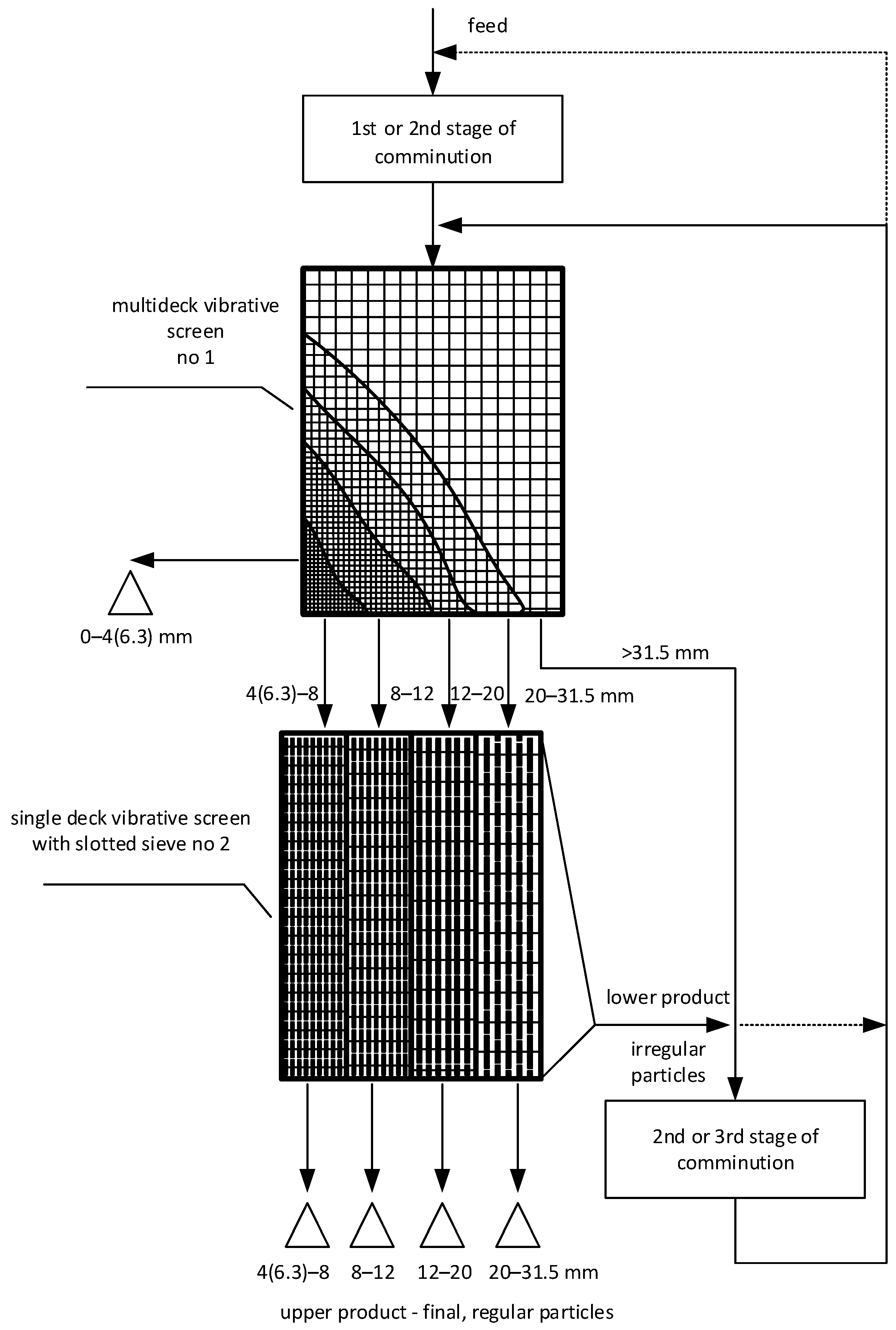
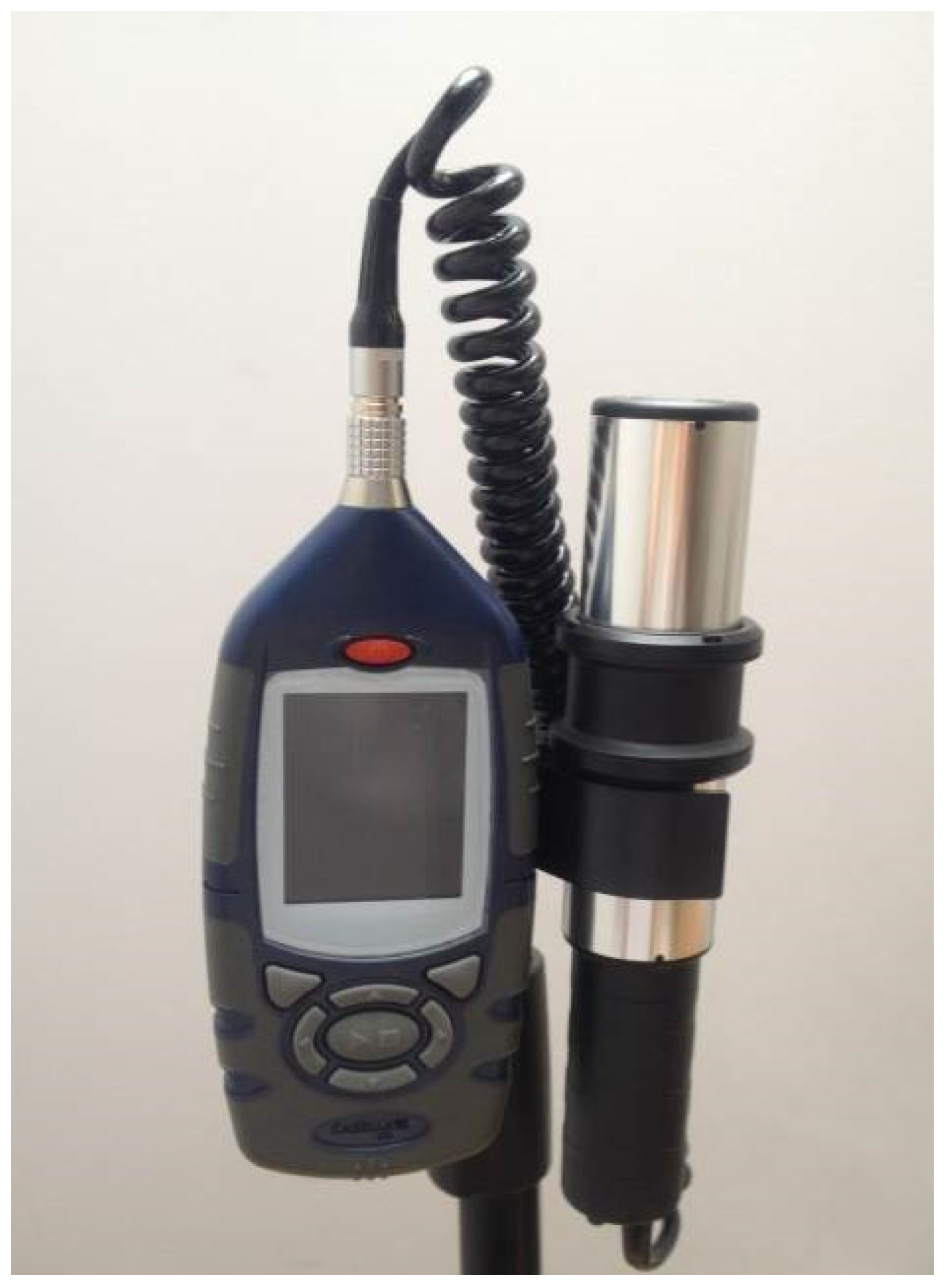


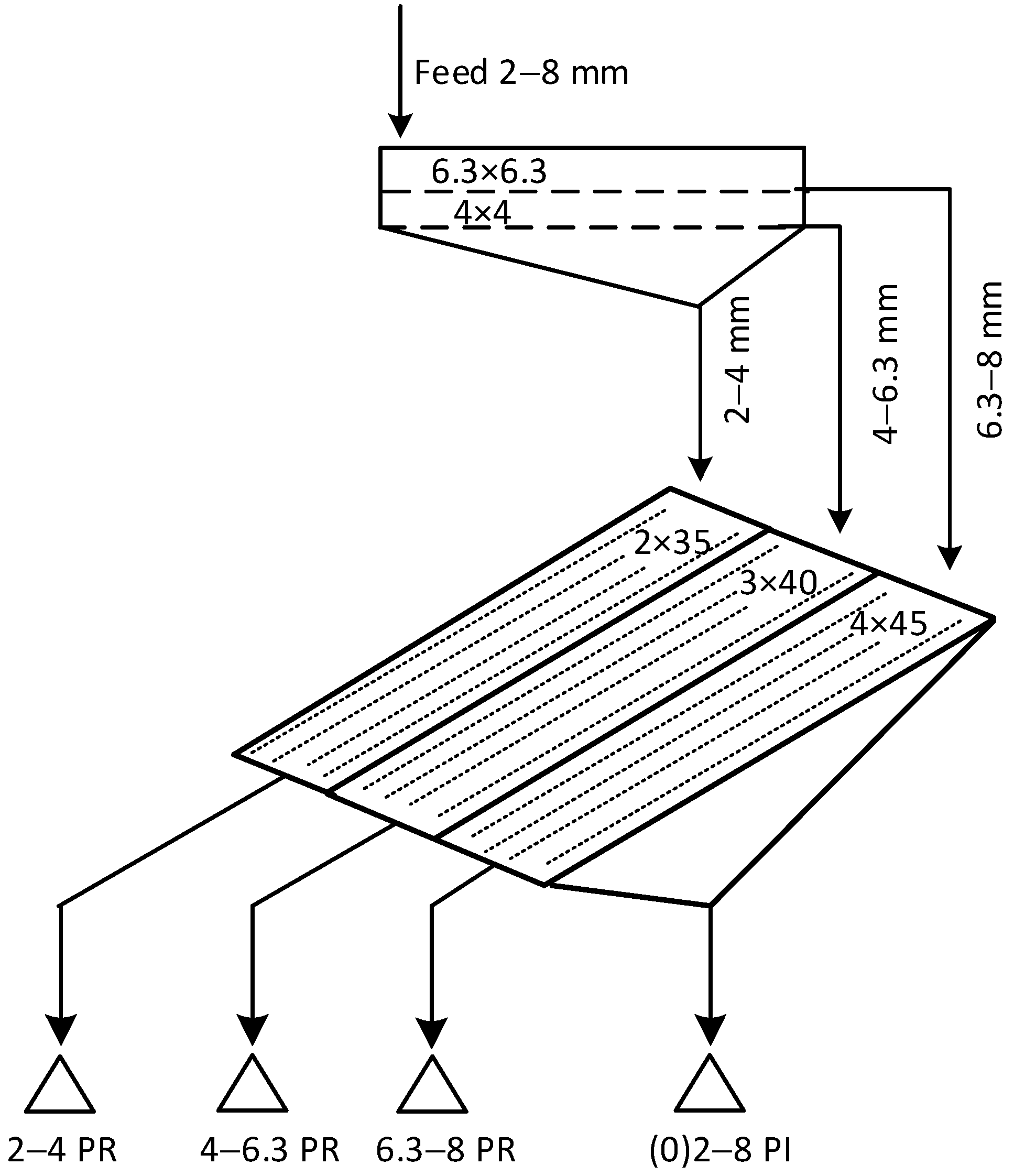
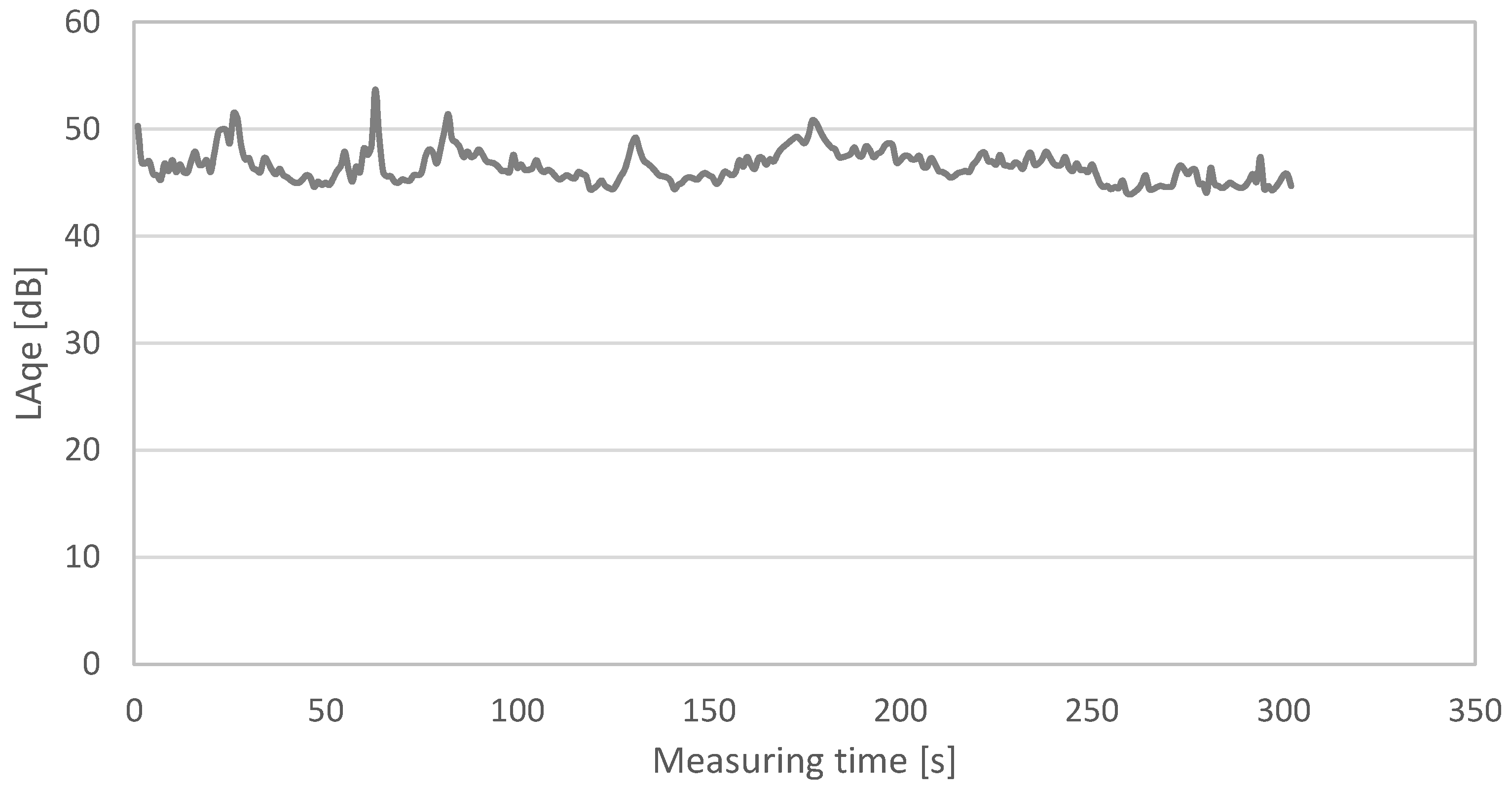
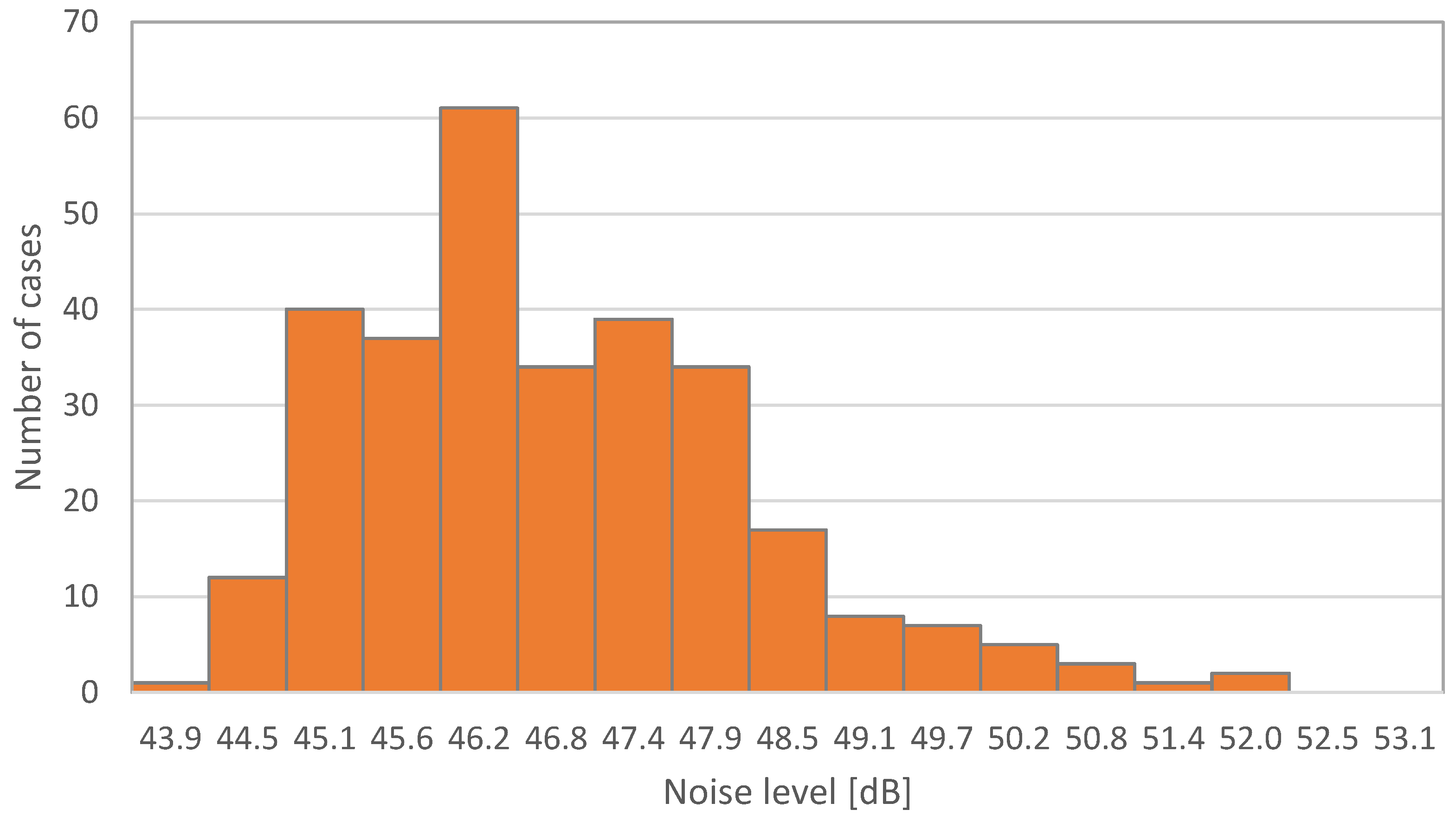
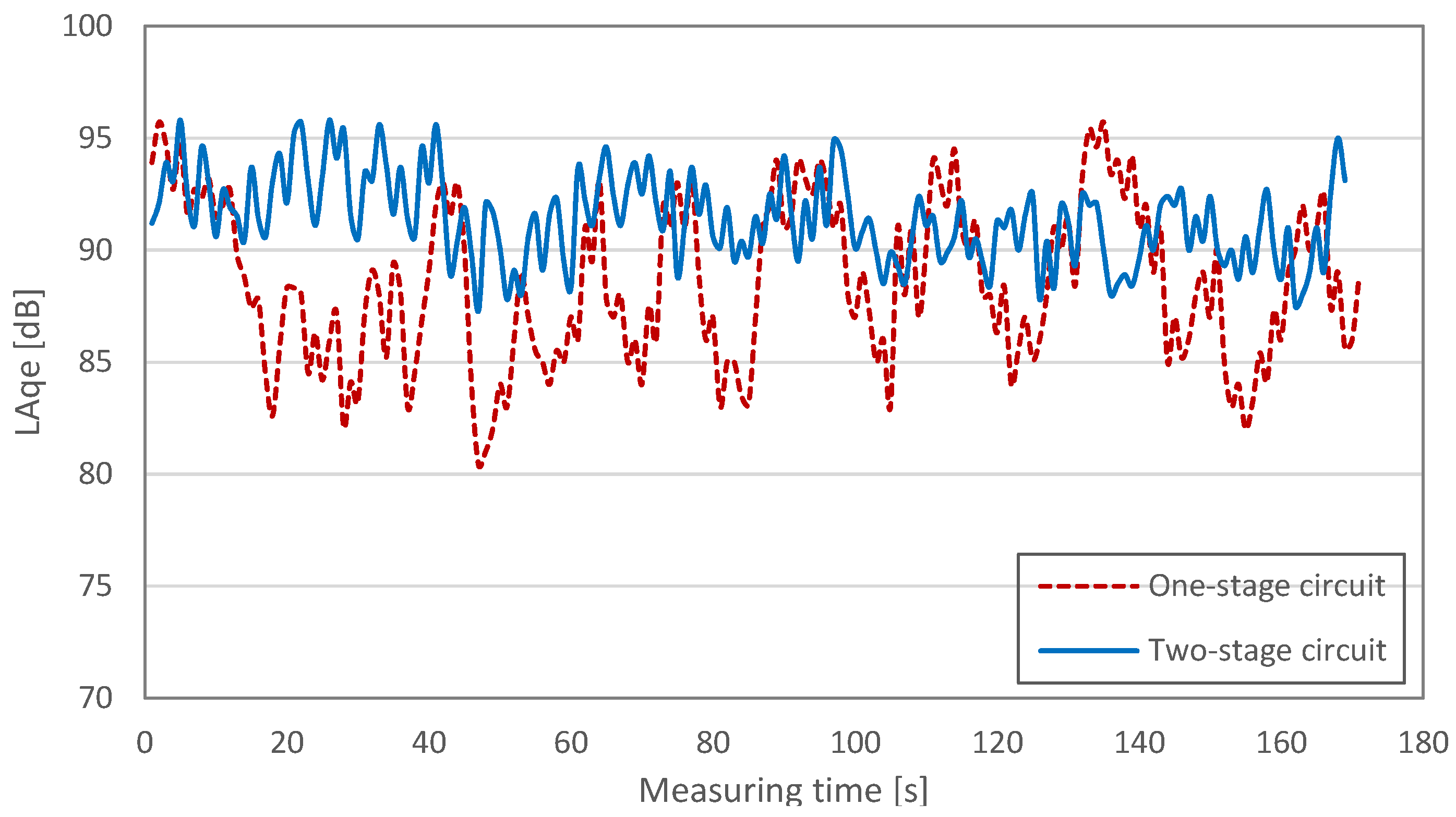

| Type of Measurement | LAeq [dB] | Extended Uncertainty Range [dB] | ||
|---|---|---|---|---|
| Measurements | Average | St. Dev | ||
| Background (number of single data points: 300) | 46.5 | 1.51 | 0.34 | |
| One-stage circuit (number of single data points: 180) | 88.50 87.18 87.52 88.01 | 87.80 | 0.50 | 1.83 |
| Two-stage circuit (number of single data points: 180) | 91.40 91.47 90.81 91.75 | 91.35 | 0.34 | 1.26 |
| Average Value [mg/m3] | St. Dev. [mg/m3] | Maximum Value [mg/m3] | |
|---|---|---|---|
| Background (1) | 0.16 | 0.10 | 0.42 |
| One-stage circuit | 1.20 | 0.46 | 2.93 |
| Background (2) | 0.21 | 0.10 | 0.92 |
| Two-stage circuit | 3.42 | 1.47 | 8.71 |
| Type of Area | Traffic Noise [dB] | Noise from Other Sources [dB] | ||
|---|---|---|---|---|
| LAeqD Day | LAeqN Night | LAeqD Day | LAeqN Night | |
| Spas and hospitals, outside the city borders | 50 | 45 | 45 | 40 |
| Single-family housing, schools, nursing homes, hospitals, within the city borders | 61 | 56 | 50 | 40 |
| Multi-family housing, recreational and leisure areas, residential and service areas | 65 | 56 | 55 | 45 |
| City over 100,000 residents | 68 | 60 | 55 | 45 |
| Type of Dust | Inhalable Fraction PM10 [mg/m3] | Respirable Fraction PM2.5 [mg/m3] |
|---|---|---|
| Dust particles containing free (crystalline) silica, over 50% | 2 | 0.3 |
| Dust particles containing free (crystalline) silica, between 2 and 50% | 4 | 1 |
| Other non-toxic dust particles—including those containing free (crystalline) silica, below 2% | 10 |
Publisher’s Note: MDPI stays neutral with regard to jurisdictional claims in published maps and institutional affiliations. |
© 2022 by the authors. Licensee MDPI, Basel, Switzerland. This article is an open access article distributed under the terms and conditions of the Creative Commons Attribution (CC BY) license (https://creativecommons.org/licenses/by/4.0/).
Share and Cite
Saramak, A.; Gawenda, T.; Saramak, D. Comparative Analysis of Dust and Noise Emission in Aggregate Production Systems. Minerals 2022, 12, 452. https://doi.org/10.3390/min12040452
Saramak A, Gawenda T, Saramak D. Comparative Analysis of Dust and Noise Emission in Aggregate Production Systems. Minerals. 2022; 12(4):452. https://doi.org/10.3390/min12040452
Chicago/Turabian StyleSaramak, Agnieszka, Tomasz Gawenda, and Daniel Saramak. 2022. "Comparative Analysis of Dust and Noise Emission in Aggregate Production Systems" Minerals 12, no. 4: 452. https://doi.org/10.3390/min12040452






